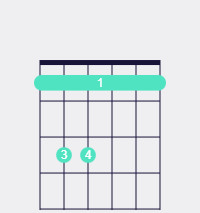Learning guitar is an exciting journey, but let’s face it, some guitar chords are more challenging than others. While a solid grasp of music theory can certainly ease your path to chord mastery, there are a few chords that consistently trip up beginners. Understanding which chords present the biggest hurdles and how to tackle them is crucial for your progress. Don’t be discouraged! Many guitarists find certain chords difficult at first. This guide will break down some of the Hardest Guitar Chords for beginners and provide you with the knowledge to conquer them.
Before we dive into specific chords, consider exploring resources like the Roadie Coach app. Tools like these can provide personalized feedback and guidance as you learn, making your practice sessions more effective. Now, let’s get to those challenging chords!
The F Chord: The Barre Chord Barrier
The F chord is often cited as the first major roadblock for beginner guitarists, and for good reason. It’s typically the first introduction to barre chords. Barre chords require you to use your index finger to press down multiple strings at once, creating a “barre” across the fretboard.
If you’re new to barre chords, the F chord can feel particularly daunting. It demands finger strength, dexterity, and precise placement. Many beginners experience frustration when learning the F chord, as it can take days or even weeks of consistent practice to play cleanly and smoothly. However, overcoming this challenge is incredibly rewarding and opens up a whole new world of chord possibilities.
To play the F chord, position your index finger across all six strings at the first fret, creating the barre. Then, place your middle finger on the G string (3rd string) at the second fret, your ring finger on the A string (5th string) at the third fret, and your pinky finger on the D string (4th string) at the third fret.
 Close-up of a hand fretting an F chord on a guitar, emphasizing the barre with the index finger.
Close-up of a hand fretting an F chord on a guitar, emphasizing the barre with the index finger.
The beauty of mastering the F chord shape lies in its versatility. This shape is movable! By shifting this same F chord shape up the fretboard, you can create other major chords. For example, move the entire shape up two frets, and you’ll be playing a G chord. Another two frets up, and you’ve got an A chord. This unlocks a vast range of major chords rooted on the 6th string, simply by sliding this fundamental barre chord shape.
Barred C Chord: Another Barre Chord Challenge
You might be familiar with the open C chord, one of the first chords many beginners learn. It’s relatively straightforward, using only three fingers. However, the barred C chord presents a different kind of challenge and is considered one of the hardest guitar chords for beginners to master. While it contains the same notes as the open C chord, just rearranged, the barre technique makes it significantly more difficult.
Just like the F chord, the barred C chord requires a barre. This time, you’ll barre across the strings at the third fret with your index finger. Then, place your middle finger on the B string (2nd string) at the fifth fret, your ring finger on the G string (3rd string) at the fifth fret, and your pinky finger on the D string (4th string) at the fifth fret.
It’s crucial to note a key difference from the F chord: the barred C chord is typically played without the low E string (6th string). You’ll strum from the A string (5th string) downwards. In fact, your barre doesn’t even need to cover the 6th string; it can focus on barring from the 5th string down.
The reason for this is that the root note of this barred C chord is on the A string (5th string). Its entire structure is built around the 5th string, unlike the F chord which is rooted on the low E string (6th string).
Similar to the F chord shape, this barred C chord shape is also movable. It serves as a template for all major chords rooted on the 5th string. For instance, move this barred C shape up two frets, and you’ll be playing a barred D major chord.
F Minor Chord: Introducing Minor Barre Chords
 Diagram showing the finger placement for an F minor chord, highlighting the slight change from the F major shape.
Diagram showing the finger placement for an F minor chord, highlighting the slight change from the F major shape.
If you’ve tackled the F major chord, the F minor chord is surprisingly accessible. Remember the F major shape? To transform it into an F minor, simply lift your middle finger off the fretboard. Yes, it’s that straightforward! This small adjustment creates a minor chord and unlocks the world of minor barre chords rooted on the 6th string.
Just like with the F major chord, you can move the F minor shape up and down the fretboard to create other minor chords. For example, moving the F minor shape up two frets will give you a G minor chord. Continue moving it to explore other minor chords with roots on the 6th string.
C Minor Chord: Applying the Minor Chord Principle
Here, we apply the same principle we used to create the F minor chord, but starting with the barred C major shape (rooted on the 5th string). To play a C minor chord, take the barred C major shape and make a slight adjustment to your finger placement.
Barre the third fret as you would for the barred C major. Then, place your middle finger on the C string (2nd string) at the fourth fret, your ring finger on the D string (4th string) at the fifth fret, and your pinky finger on the G string (3rd string) at the fifth fret.
Just like the previous barre chord shapes, this C minor shape becomes your key to playing all simple minor chords rooted on the 5th string.
Practice and Patience are Key
These hardest guitar chords for beginners, particularly barre chords like the F and barred C, will undoubtedly present a challenge at first. Your first barre chord, which is often the F chord, will likely be the toughest hurdle. However, once you conquer it, other barre chords will become progressively easier.
The most important things to remember are patience and consistent practice. Don’t get discouraged if you don’t nail these chords immediately. Break down your practice sessions, focus on clean barre technique, and gradually build strength and accuracy. With dedication and persistence, you’ll be playing these challenging chords and expanding your guitar skills in no time. So, keep practicing, stay patient, and most importantly, have fun with your guitar learning journey!
